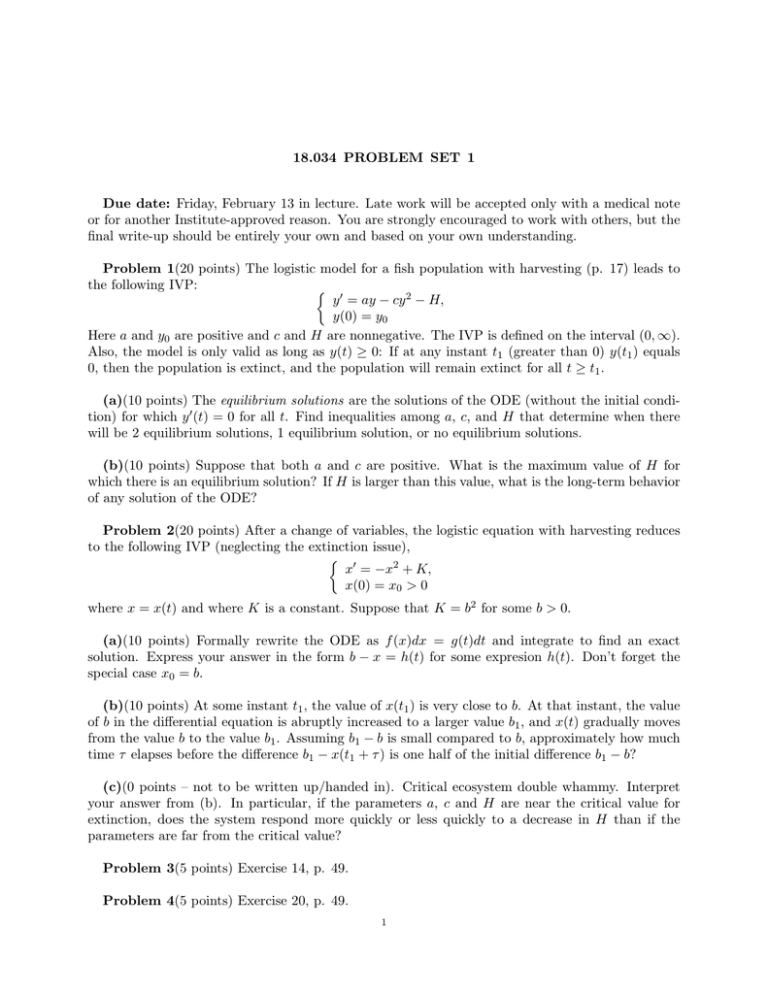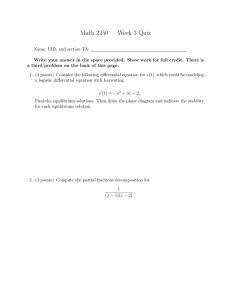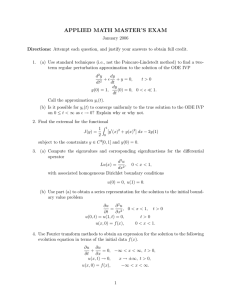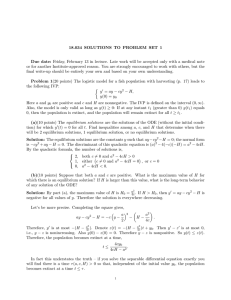18.034 PROBLEM SET 1
advertisement

18.034 PROBLEM SET 1 Due date: Friday, February 13 in lecture. Late work will be accepted only with a medical note or for another Institute­approved reason. You are strongly encouraged to work with others, but the final write­up should be entirely your own and based on your own understanding. Problem 1(20 points) The logistic model for a fish population with harvesting (p. 17) leads to the following IVP: � � y = ay − cy 2 − H, y(0) = y0 Here a and y0 are positive and c and H are nonnegative. The IVP is defined on the interval (0, ∞). Also, the model is only valid as long as y(t) ≥ 0: If at any instant t1 (greater than 0) y(t1 ) equals 0, then the population is extinct, and the population will remain extinct for all t ≥ t1 . (a)(10 points) The equilibrium solutions are the solutions of the ODE (without the initial condi­ tion) for which y � (t) = 0 for all t. Find inequalities among a, c, and H that determine when there will be 2 equilibrium solutions, 1 equilibrium solution, or no equilibrium solutions. (b)(10 points) Suppose that both a and c are positive. What is the maximum value of H for which there is an equilibrium solution? If H is larger than this value, what is the long­term behavior of any solution of the ODE? Problem 2(20 points) After a change of variables, the logistic equation with harvesting reduces to the following IVP (neglecting the extinction issue), � � x = −x2 + K, x(0) = x0 > 0 where x = x(t) and where K is a constant. Suppose that K = b2 for some b > 0. (a)(10 points) Formally rewrite the ODE as f (x)dx = g(t)dt and integrate to find an exact solution. Express your answer in the form b − x = h(t) for some expresion h(t). Don’t forget the special case x0 = b. (b)(10 points) At some instant t1 , the value of x(t1 ) is very close to b. At that instant, the value of b in the differential equation is abruptly increased to a larger value b1 , and x(t) gradually moves from the value b to the value b1 . Assuming b1 − b is small compared to b, approximately how much time τ elapses before the difference b1 − x(t1 + τ ) is one half of the initial difference b1 − b? (c)(0 points – not to be written up/handed in). Critical ecosystem double whammy. Interpret your answer from (b). In particular, if the parameters a, c and H are near the critical value for extinction, does the system respond more quickly or less quickly to a decrease in H than if the parameters are far from the critical value? Problem 3(5 points) Exercise 14, p. 49. Problem 4(5 points) Exercise 20, p. 49. 1






